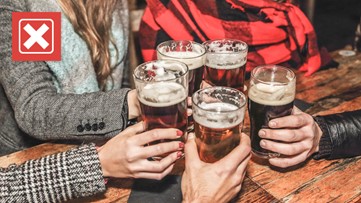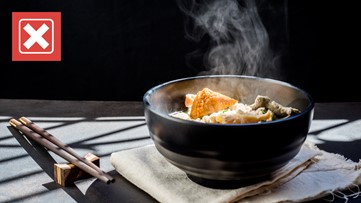February is Black History Month in the United States. It’s a time when the nation honors and acknowledges notable Black Americans and their contributions to society.
In early February, a viral post on X, which has since been deleted, claimed George Washington Carver, one of the most prominent Black scientists of the early 20th century, invented peanut butter. Some people who commented on the post said it was false.
Similar claims have been circulating for years. Some people say they were taught Carver invented the nutty spread in grade school while others say Nickelodeon made the claim when they were kids.
THE QUESTION
Did George Washington Carver invent peanut butter?
THE SOURCES
THE ANSWER
No, George Washington Carver did not invent peanut butter.
WHAT WE FOUND
George Washington Carver was a renowned educator, agricultural scientist and innovator who developed over 300 uses for peanuts throughout his lifetime. However, our sources say he did not invent peanut butter.
“Contrary to popular belief, George Washington Carver did not invent peanut butter. He was a pioneer in the agricultural world and many refer to him as the father of the peanut industry. His innovations increased the legume’s popularity and made peanuts a staple in the American diet,” the National Peanut Board says.
Carver was born into slavery on a farm near Diamond, Missouri, at the time of the Civil War. His exact birth date and year are unknown, however, historians believe he was born between 1860 and 1865.
When Carver was a baby, he was orphaned after his mother was kidnapped by slave raiders and sold in Kentucky. When slavery was abolished in 1865, he was raised by Moses and Susan Carver, his mother’s former owner and his wife, who taught him how to read and write.
Carver was a frail, sickly child who spent the majority of his time completing chores and tending to the garden on the farm, where he developed an interest in plants, according to the National Inventors Hall of Fame. He quickly became known as “the plant doctor” by nearby farmers for his ability to improve the health of their fields and crops.
At age 11, Carver left home to attend a school for Black children in Neosho, Missouri. A few years later, he moved to Kansas where he eventually graduated from Minneapolis High School in Minneapolis, Kansas.
After earning his high school diploma, the Science History Institute says Carver found that opportunities to attend college for young Black men in Kansas were nonexistent. So, in the late 1880s, he relocated again to Iowa, where he was encouraged to enroll at Iowa State Agricultural College, now Iowa State University.
Carver became the first Black student to attend Iowa State in 1891, according to the National Park Service. He earned his bachelor’s degree in agricultural science in 1894 and a master’s degree in 1896.
Around this same time, famed intellectual and educator Booker T. Washington was working to establish an agricultural department and research facility at his Tuskegee Normal and Industrial Institute, now Tuskegee University, in Alabama. Washington reached out to Carver, the only Black person in the U.S. with an advanced degree in agricultural science, and asked him to join the faculty.
Carver worked at Tuskegee for 47 years as a teacher and researcher, leading the institute’s Agricultural Experiment Station. His primary interest was using chemistry and scientific methodology to improve the lives of impoverished farmers in southeastern Alabama, according to the Science History Institute.
“He conducted soil studies to determine what crops would grow best in the region and found that the local soil was perfect for growing peanuts and sweet potatoes,” the Science History Institute says. “He also taught farmers about fertilization and crop rotation as methods for increasing soil productivity.”
While farmers were pleased with the results of this new farming method, the National Inventors Hall of Fame says many found themselves with a surplus of peanuts and sweet potatoes, which many people did not eat at the time. Carver attempted to solve this problem by inventing many different agricultural and industrial uses for these crops, finding his greatest success with peanuts.
“When he first arrived at Tuskegee in 1896, the peanut was not even a recognized U.S. crop,” the Science History Institute says. “By 1940, it had become one of the six leading crops in the nation and the second cash crop in the South.”
The National Park Service says Carver developed 325 uses for peanuts and 108 applications for sweet potatoes. Some of the products he created include chili sauce, meat tenderizer, instant coffee, shaving cream and Worcestershire sauce. But not the peanut butter we eat today.
So if Carver didn’t invent peanut butter, who did?
The National Peanut Board says one of the earliest references to peanut butter can be traced back to the Ancient Incas and Aztecs in Central and South America who ground roasted peanuts into a paste. But there is some debate among culinary historians about who was the first to create modern peanut butter in the U.S., according to the Library of Congress.
In 1884, Canadian chemist and pharmacist Marcellus Gilmore Edson received a patent from the U.S. Patent and Trademark Office to create a peanut paste, which he named “peanut-candy.” Peanut-candy was “made by roasting peanuts and grinding them between surfaces heated to a temperature of 100 degrees Fahrenheit. When cooled, this product had ‘a consistency like that of butter, lard, or ointment,’” the Canadian Encyclopedia says.
About a decade later, in 1894, George A. Bayle Jr., the owner of a food products company in St. Louis, was asked by a doctor to make a ground peanut paste as a nutritious protein substitute for his patients with poor teeth who could not chew meat. Bayle packaged and sold the peanut butter in the form of a snack food for 6 cents a pound, according to multiple news reports and the History Colorado Center, a museum in Denver, Colorado.
In 1895, American businessman and physician John Harvey Kellogg, who is also known for inventing Kellogg’s Corn Flakes breakfast cereal, experimented with peanuts and eventually patented his version of peanut butter using peanuts that he boiled or steamed before making them into a paste. Kellogg’s peanut butter product was used as a vegetarian source of protein for his patients at the Battle Creek Sanitarium, a popular medical spa resort he managed for several decades.
Around the turn of the century, the Library of Congress says the Atlantic Peanut Refinery in Philadelphia, Pennsylvania, introduced peanut butter made with roasted nuts instead of boiled nuts. According to the research library, their “nut butter” was called peanut butter, the name that is primarily used today.
In 1903, the production of peanut butter was simplified when St. Louis physician Ambrose Straub patented a machine to make peanut butter. Peanut butter was widely introduced to the public at the 1904 World’s Fair in St. Louis by a man named C.H. Sumner.
Nearly two decades later, in 1922, the History Colorado Center says California businessman Joseph L. Rosefield developed and patented hydrogenated peanut butter, which was made using a partial-hydrogenation process to keep the oil from separating and finer grinding. This created a creamy, buttery texture, unlike earlier versions of peanut butter that were described as gritty or pasty.
Rosefield’s peanut butter had a shelf-life of up to a year, meaning it was able to be shipped across the country, stocked in warehouses and left on shelves nationwide. Southern Peanut Growers says one of the first companies to adopt Rosefield’s process was Swift & Company, which was later renamed Peter Pan. By 1933, Rosefield founded Skippy brand peanut butter, which was less sticky and longer-lasting than his original hydrogenated peanut butter, according to Hormel Foods.
In 1958, Procter & Gamble entered the peanut butter business and introduced Jif brand peanut butter. Jif, which the J.M. Smucker Company now owns, operates the world’s largest peanut butter plant, producing 250,000 jars every day, Southern Peanut Growers says. Now, Jif, Peter Pan and Skippy are the most popular peanut butter brands in the U.S.












